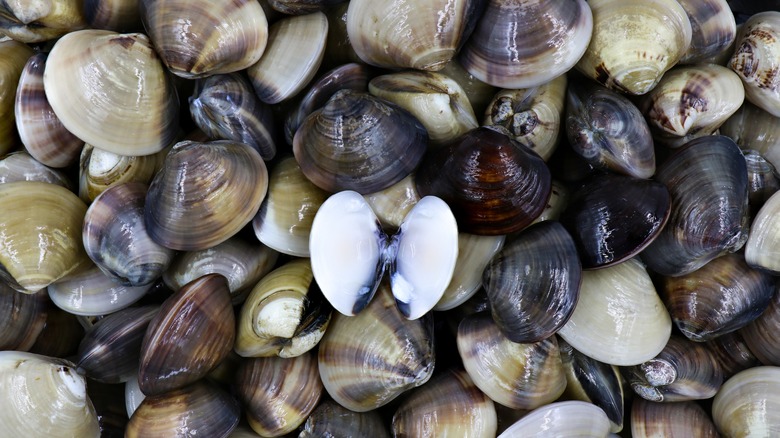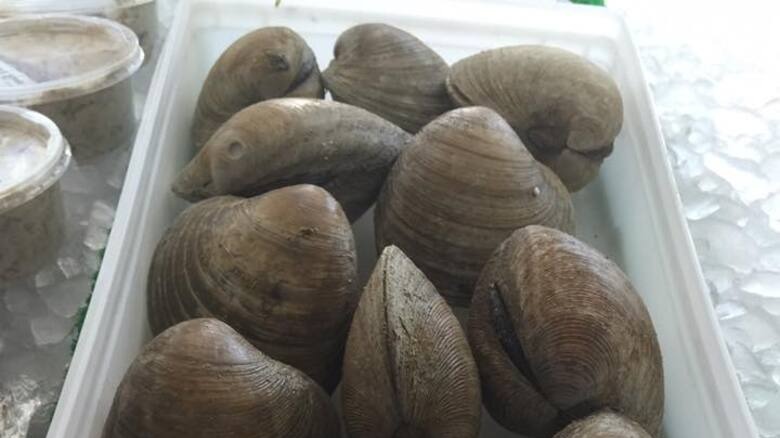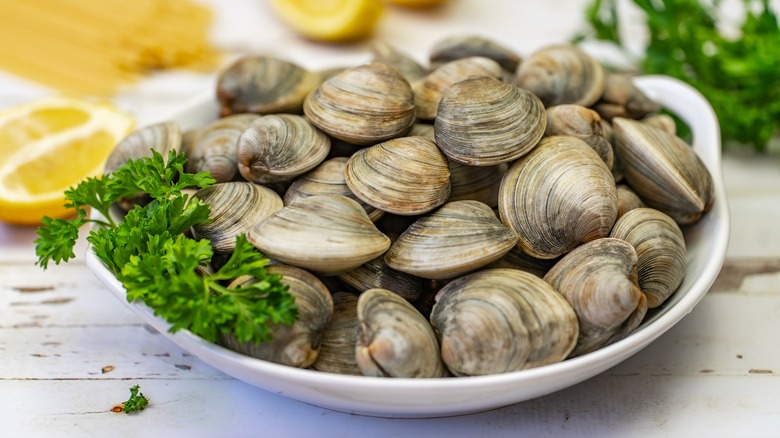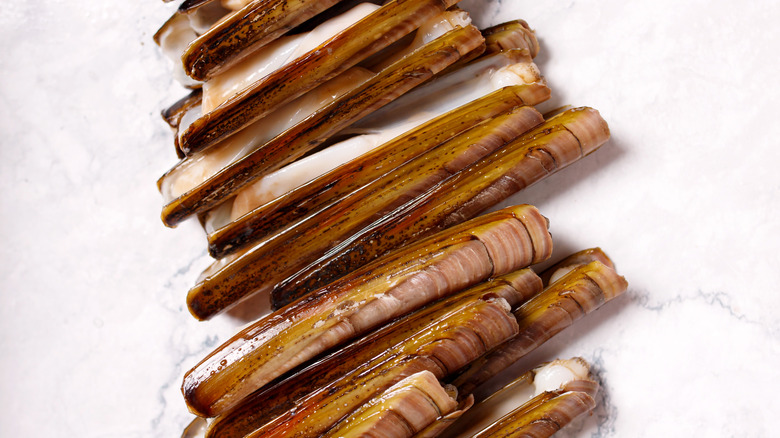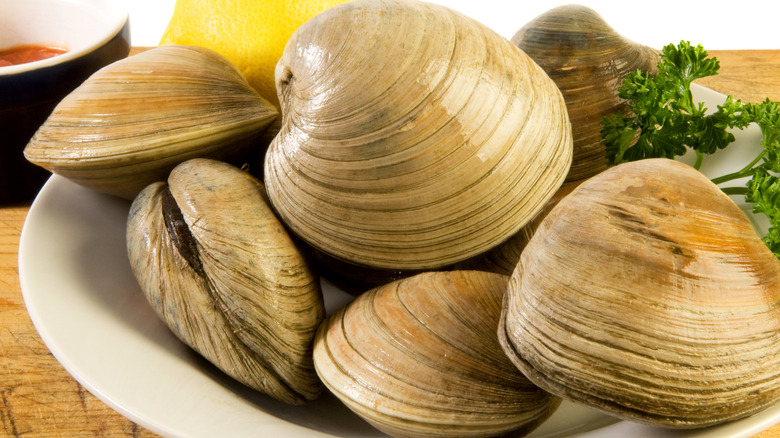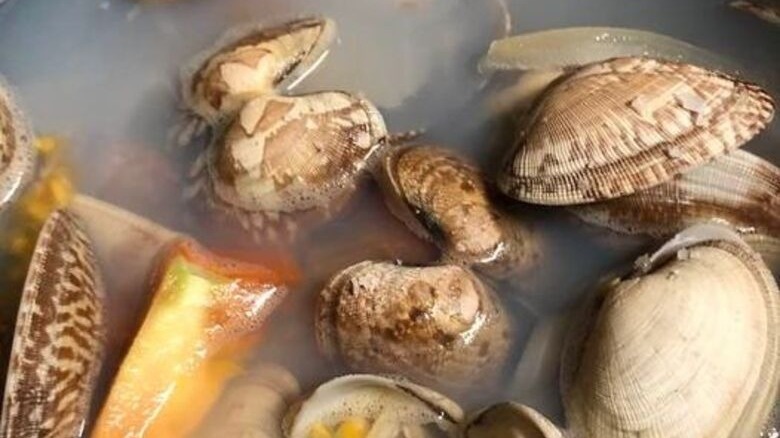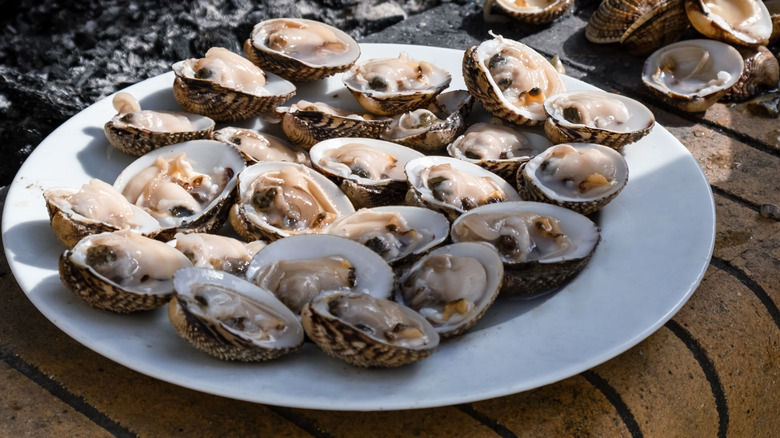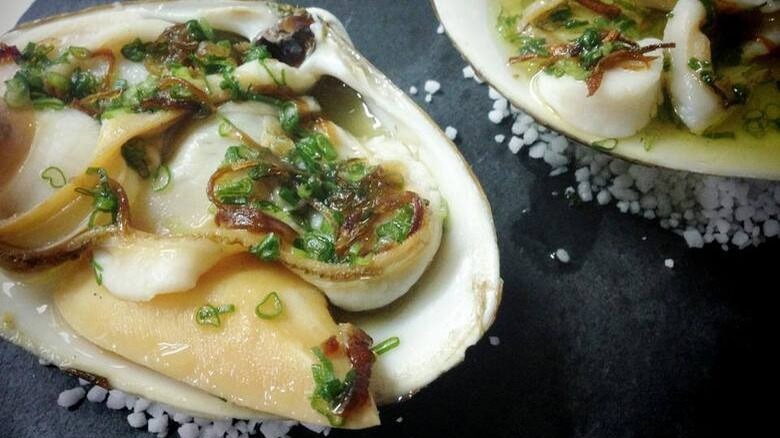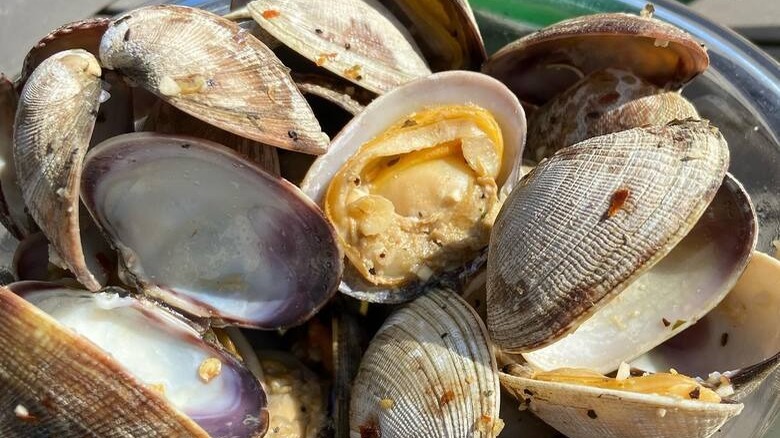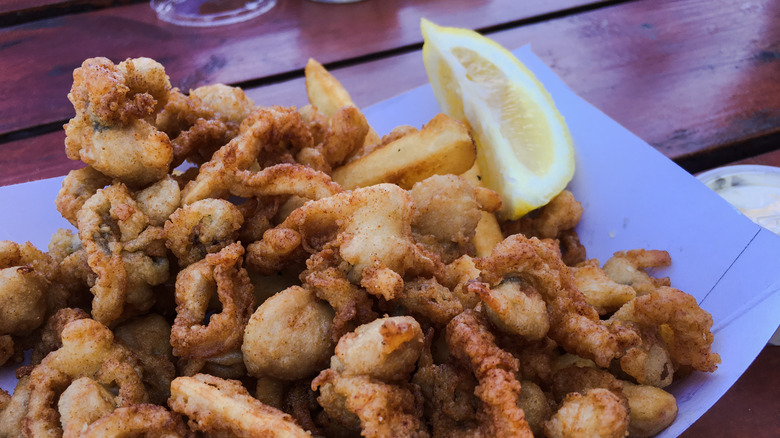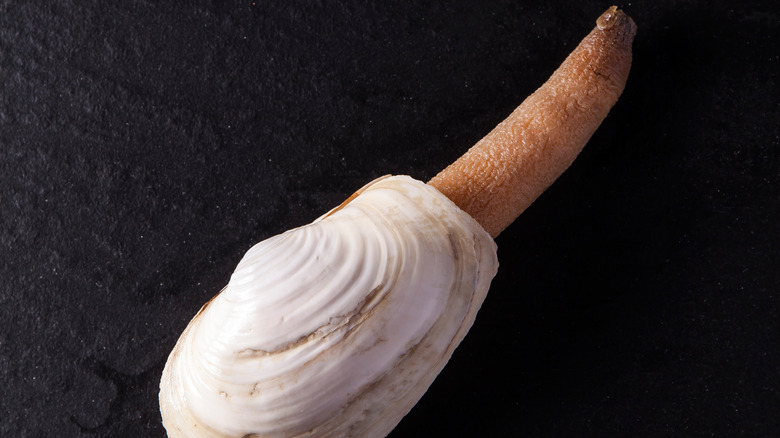11 Types Of Clam And How To Eat Them
Popular for all the right reasons, nothing can beat the taste of freshly steamed clams, especially ones that have been topped with garlic butter and lemon juice. However, that's not the only way you can devour these beauties. From steaming to frying, poaching and grilling, the cooking possibilities for clams are practically endless. Use them in your favorite chowder recipe, soups, a casserole, or as an appetizer. Whatever way you choose to use them, clams don't disappoint.
However, that isn't the only reason you should be eating clams. Clams are a powerhouse of nutrients. As per LiveStrong, clams are rich in vitamin B12, which is essential for blood cell production. The high levels of omega-3 fatty acids in clams can improve your heart health and clear your skin, too. And, as Healthline notes, clams and other shellfish may help to improve men's fertility.
Like all seafood species, clams come in several varieties, each with a unique flavor profile, texture, and ideal cooking preparation. So, how is a regular person supposed to know the difference between a quahog and a littleneck? The next time you are at a loss for which clam variety will go best in your chowder, never fear. We're here to help. Here are 11 popular clam varieties and the best ways to eat them.
Quahog clams
Pronounced "kow-hog," quahog clams are as delicious as the name sounds. Growing to a maximum length of 5 inches, quahogs have wide varieties. However, the smaller clams are best for cooking. They have tender meat with a sweet yet salty flavor when steamed (via Chef's Resources).
As per Men's Journal, the best way to get perfectly steamed clams is by first getting your hands on a good batch of quahogs. Next, place the tightly closed clams (any open ones go into the trash) in cold water to wash out sand. Steam them for 5-7 minutes and serve with drawn butter to truly enjoy the flavors from the sea.
When picking quahogs, you may encounter the problem of toxic algae growth. NOAA fisheries screen the problem, though it encourages consumers to avoid eating shellfish raw. That decision can cause shellfish poisoning, which may lead to some pretty unpleasant gastrointestinal problems, per WebMD.
You can deploy these beauties in a delicious baked clam dish with bread crumbs, bell pepper, and bacon. If you are in the mood for something hearty and comforting, you can also use them in filling clam chowder. You can also enjoy these large shellfish by grilling them to open up or steaming them for a briny, buttery mouthful. Whatever way you choose to cook them, quahogs don't disappoint.
Littleneck clams
Contrary to its name, littlenecks don't actually have little necks. They are called so because of their small size. Littlenecks are technically quahogs, but the reason we can classify them separately is due to their size. A quahog is the largest hard-shell mollusk you can typically use for chowder. However, littlenecks are far smaller and have tender meat that can be eaten raw or steamed (via Greatist).
According to the Cape Porpoise Lobster Co, these smallest of the hardshell clams are especially suited to cooking methods like grilling, steaming, or even eating raw. You can expect to receive seven to 10 clams in a pound. As for taste, littlenecks have a subtle sweetness with salty notes. Texture-wise, the mollusk's meat is tender and can fall apart easily in your hands, depending on how it's prepared.
Perhaps the best way to truly appreciate the flavor of littleneck is by steaming it. Since clams typically take only a few minutes to cook, steamed littlenecks are perfect for a quick bite and as a side dish. Make sure to season the clams with a generous drizzle of butter for enhanced flavor.
Razor clams
Perhaps the most enticing of all clam species, razor clams are incredibly fast, as the Ocean Conservancy reports. Their name is inspired by the fact that they look like old-school straight razors, with thin, razor-sharp valves that can give you some serious cuts if you accidentally touch the edges of their shells while out digging for these mollusks. Another distinctive quality of razor clams is that they have zippers, though these features aren't exactly like the zippers on pants. Instead, it's a feature of the clam's mantle.
These mollusks inhabit the beaches from California to Alaska and can dig more than 20 centimeters per minute to hide from predators. This means that you'll have to search far and dig deep to get hold of these suckers. You'll also have to set a pretty good digging pace, as razor clams have super muscular feet, giving them the ability to bury themselves quickly. If left on the surface, adult clams quickly re-burrow mud and sand using their feet (via Fisheries and Oceans Canada).
With razor clams, you aren't just limited to a single flavor. As per Direct Seafood, the foot of a razor clam is chewy due to its muscular nature with a sandy taste. The center, however, is green and has a sweet flavor, while the top part is the classically white, tender flesh we all look for while eating clams. Enjoy them pan-fried or steamed. Since they are mildly flavored, consider complementing them with a rich sauce.
Cherrystone clams
These mollusks are named because of their natural habitat, the Cherrystone Creek Watershed (via DelightedCooking). The older version of littleneck clams, cherrystones, can grow up to three inches. In comparison, littlenecks typically grow to one and a half inches and are harvested at a relatively early point in their life cycle. Though you can count the growth rings on clam shells to estimate their age, these rings aren't very distinctive at the more mature cherrystone stage, though (via Mom.com)
As per DelightedCooking, cherrystone clams have hard, chewy meat compared to littlenecks, which makes them a better option for chowder and clam cakes. Leaf notes that you must thoroughly clean these clams by soaking them in salted water and brushing the shells with a vegetable brush to make sure that you've removed any environmental debris. For an extra level of deliciousness, serve cherrystone clams with sautéed onions and a wine-based sauce and butter.
Manila clams
While it carries the same name as the capital city of the Philippines, the truth is that this clam species is not native to that region. Instead, they were inadvertently carried to British Columbian waters from Japan in the 1930s and became an invasive species, as per Nature. Now, you can spot these clams with their distinct purple shells blotched with a yellow hue in a variety of places North America (via Mom.com).
Manila clams are popular among seafood enthusiasts due to their remarkably sweet flavor and smooth texture. Since the cooking options for Manila clams are so vast, including boiling, poaching, baking, and steaming, they are a chef's favorite.
Want to do you part to take down the numbers of this invasive species and get a good meal in besides? Celebrity chef Rachael Ray has presented an easy way to prepare these clams in a scrumptious spicy clam recipe that incorporates spicy pork sausage, alongside shallots and garlic.
Cockle
If you visit the sea often, chances are high that you have encountered these clams on the shore. Unlike the sand-digger razor clams, cockles typically stay on the surface of low tidal areas. You probably don't even have to dig into the sand to find one. Instead, you can use a gardening rake to collect these creatures, or even simply pick them up by hand (via the Oregon Department of Fish & Wildlife).
According to Great British Chefs, these clams weren't always a popular choice, being that there were once considered lower-class food in British society. However, they can now grace tables in fine dining restaurants across the UK.
You can enjoy these heart-shaped mollusks, which typically turn orange when cooked, served with a savory garlic butter. Simply start by boiling them in salted water until they open up, and then serve them with drawn butter made with paprika, garlic, and lemon juice. Be sure away the clams that don't open after cooking, as chances are they were already dead when you began cooking or else full of mud, either of which makes for a nasty dining experience (via Tony's Meats & Market).
Atlantic surf clams
New Englanders know their Atlantic surf clam strips very well indeed. For many who live in or visit the region, not a single summer passes without enjoying these fried treats. These clams are pretty hefty, with massive bodies that can grow nearly to a whopping nine inches (via NOAA Fisheries).
The meat of this large mollusk is not quite as tender as some small clam varieties, though there's a reason why: back in the day, soft shell clams were rare. In the 1930s, a picky clam digger named Thomas Sofforon, who didn't like the meat from Atlantic surf clams, started to fry strips of the tougher bivalves, as Vice reports. The result caught the attention of restaurant chain Howard Johnson's, leading to a 32-year partnership between Howard Johnson's and Sofforon.
Pangea Shellfish Company notes that these clams are shucked in processing facilities, with their brine is packaged separately from the clam's meat. The bellies are discarded, while most other parts are chopped to make clam mince. Finally, the feet of these beauties are used for the now-prized fried clam strips
Butter clams
Also known as Washington clam, Martha Washington clam, or money shell, butter clams are nearly 3-4 inches long and exceptional burrowers, capable of diving up to 35 centimeters into the sand. You can find them in a variety of beaches and even in rivers, though they prefer high-salinity water (via Oregon Department of Fish & Wildlife).
However, if you want to dig the sand and find these non-shiny shells, you need a license. According to the Washington Department of Fisheries and Wildlife, you cannot harvest butter clams smaller than one and a half inches in length across the shell. The ODFW warms clammers to be careful while digging, as they may end up chopping off the necks of these clams. Moreover, a sharp broken shell can inflict a nasty cut on your hand.
As far consuming the mollusk, Walla Walla University advises against consuming the black neck of this variety, as it may carry paralytic shellfish poisoning (PSP) agents. Although other sea predators who prey on these mollusks can spot the PSP, humans cannot. To stay safe, make sure that you cut the necks off before cooking butter clams, usually via steaming or boiling. To take it a step further, you may also chop up clam meat for other dishes like chowder and a seafood-rich paella.
Ipswich clams
Another food accident that paved the way for a whole industry involves Ipswich clams. These soft-belly clams, unlike some larger varieties, don't need gut cleaning. Instead, you can consume them entirely. Credit for frying this variety belongs to Bessie and Lawrence Woodman, a Massachusetts couple who owned a roadside food stand where they sold fried potatoes and cooked clams. A fishmonger suggested battering and frying the clams when Lawrence complained of slow business. The desperate couple followed the advice and it became a huge success that was copied by many other restaurants in the region (via The New York Times).
Saveur compares the taste of Ipswich clams to briny oysters, though it warns seafood lovers to prepare for some grit in the hand-picked soft shells. They're nearly always collected by hand, too, as their shells are so fragile that you need to harvest them carefully and ideally without the use of any tools.
Geoducks
Pronounced as "gooey-duck," Eater notes that the name of these clams goes back to Washington's Nisqually tribe, who named these mollusks "gweduc," for the mollusk's ability to "dig deep." Despite what you may think, geoducks have nothing to do with the earth. Still, the pronunciation isn't the main hook here. Instead, the appearance of these mollusks is.
The Smithsonian compares the mollusk's neck to a baseball bat and a wrinkled nub (the neck can extend and retract). The most interesting comparison, however, is to a prehistoric giant earthworm. Being the largest burrowing mollusks, geoducks can grow to more than two pounds in their natural habitat of Puget Sound. The Washington Department of Fish and Wildlife reports that the largest geoduck ever caught came in at 8.16 pounds in 2000.
As for cooking, Nick Digiovanni notes in Eating a Geoduck Clam that you can use the cleaned clam in any dish of your choice, including a chowder or as fried clams. However, you choose to cook them, geoducks taste deliciously clean and crisp.
Dog cockles
Don't expect a dog-shaped clam if you hear "dog cockle." The reason for the name isn't obvious. Perhaps the cream-colored clam shells with dark brown blotches make these mollusks resemble a Dalmatian. The Wildlife Trusts notes that, beneath the shells of these clams, there are teeth for dealing with predators. These clams are a European delicacy known as "Amandes de Mer" in French due to their sweet flavor, which translates to sea almonds. However, Behind the French Menu doesn't want novice French learners to get confused by the name. These clams are often served as "amandes" in French seafood restaurants.
Nitty Grits notes that dog cockles are sweet and reminiscent of hazelnuts. Don't go overboard with the sauce, though. These delicious clams taste best on their own, not smothered with rich sauces. A light fry in garlic butter and with a sprinkling of parsley should do the trick.
